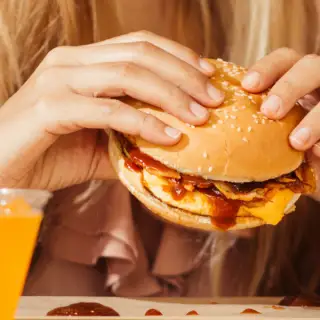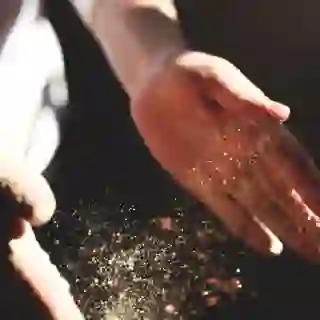Despite the massive efforts of researchers, it’s impossible to say why one person gets cancer and another doesn’t. Between genetics, lifestyle choices, environmental exposures, and yes, even plain bad luck, we may never be able to point to a definitive reason. But that doesn't mean you don't have any power over breast, colon, lung cancer, and more. In fact, there are a few simple steps you can take that may help reduce your odds. Steering clear of these eight common carcinogens is a great place to start.
Excessive Drinking
Consuming alcohol is linked to certain types of cancer, including head and neck, esophageal, liver, breast, and colorectal cancers. And the more you drink, the higher your risk. Researchers think that the chemical your body produces when it metabolizes alcohol may damage DNA. That damaged DNA, in turn, may lead to cancer. If you want to avoid the risk entirely, you can abstain from drinking alcohol. Although, this is only true for certain cancers. Furthermore, the possible limited benefit of alcohol consumption is likely outweighed by the harms.
Smoke
We know you’ve heard it before, but the fact remains: Smoking causes cancer (second-hand smoke included). “It has to be said,” notes Tasha Stoiber, Ph.D., a senior scientist at Environmental Working Group. “It’s the most obvious carcinogen, and the one where people can make a change.” (Check out these quitting resources from the Centers for Disease Control.)
For kids and teens, the key is to never start, says Aparna Bole, Ph.D., chair of the Council on Environmental Health. But with the recent boom in e-cigarettes, pediatricians are scrambling to prevent a new generation of smokers. “E-cigarettes are very expensive, and we’re seeing adolescents and young adults getting hooked on them, they often switch to cigarettes, which are cheaper,” Dr. Bole says.
Sun
Don’t worry, you can still go to the beach. And you don’t have to avoid the sun all the time, but anything you do to lessen your exposure is helpful, Dr. Stoiber says. “Obviously, the most important thing is to avoid the sun during peak hours and wear protective clothes, including a hat and sunglasses,” she says. And don’t forget to slather on the sunscreen daily! Consider a product that physically blocks the sun with zinc oxide or titanium dioxide, especially on kids. (Bonus: Physical blockers have improved in recent years, meaning you no longer have to look like a ghost after rubbing it in).
Contaminants in Dust
There’s a whole host of industrial chemicals linked to cancer, Dr. Bole says, but, unless you live in a bubble, it would be extremely difficult to avoid them all. You can, however, substantially reduce your exposure. Remove shoes indoors, vacuum floors regularly, and use a damp cloth to dust surfaces where contaminants accumulate, Dr. Stoiber says. “Getting rid of the dust is a good measure to take.” The next step would be to clean with simple ingredients: Distilled white vinegar and water can do the task of most name brand cleaning products--and, it’s easier on the wallet.
Red and Processed Meat
Skip the processed meat (buh-bye, bologna) and cut way back on beef, and you’ll make a significant dent in your risk of getting colorectal and other cancers. Replace them with a rainbow of fruits and veggies, like kale, blueberries, and sweet potatoes, and lower your risk even more.
Why are some foods such superpowers? Scientists think that the nutrients found in these foods reduce what’s called the “hallmarks of cancer.” Think of these “hallmarks” as the characteristics that differentiate cancer cells from healthy ones. While certain foods (red meat) can have a negative impact on hallmarks, other foods (veggies) can have a positive impact on preventing them.

Radon
Radon, a radioactive gas, forms naturally when radioactive metals break down in the earth. It can seep into your home through cracks and get trapped in your lungs when you breathe it in, increasing your chances of developing lung cancer.
The Environmental Protection Agency estimates radon could account for 20,000 lung cancer deaths in the U.S. each year, second only to smoking. The good news? It’s easy to test your house (you can order a kit online here or pick one up at a home improvement store).
If levels are high, you'll want to hire a radon mitigation company. Find certified pros through the National Radon Safety Board.

Contaminants in Drinking Water
Do you know what’s in your water? If you’re not sure, send off a sample to get tested. The top contaminants of concern for cancer in drinking water are arsenic, hexavalent chromium, and radioactive elements such as uranium and radium, according to a study published in the journal Environmental Health that analyzed drinking water in California. Researchers estimated that drinking from the United States’ water system over the course of a lifetime could contribute to 15,500 cancer cases; the combination of chemicals often found together may contribute to a greater risk. Remember that even if your water follows regulations, it may still contain certain contaminants, Dr. Stoiber says. In other words, filtering still makes sense.

Unnecessary Medical Imaging
Radiation for medical purposes (think X-rays at the dentist, CT scans, etc.) builds up over a lifetime. That means you should be asking questions every time a scan is suggested. Simply say, “Why do I need that?” Dr. Bole suggests. “And is there a modality that provides less radiation?” It’s particularly important to avoid unnecessary radiation in childhood, so most pediatricians are on top of this, Dr. Bole adds. Of course, sometimes radiation is medically necessary. “Many kids with chronic illnesses need it, so it’s just important to be thoughtful about it,” she says, “and for parents to be empowered to ask about it.”





